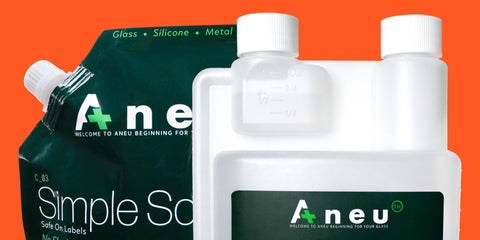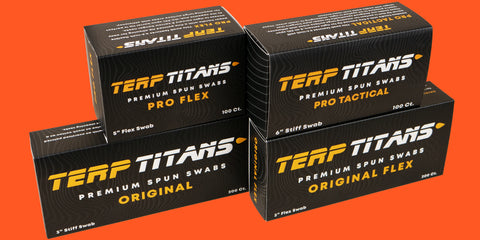Before delving into the intricate science behind cleaning agents, it's useful to understand what sets sophisticated cleaning solutions apart from more traditional methods. Modern formulations—exemplified by products like Hygenix's Aneu line—are crafted from a careful blend of ingredients. They typically combine advanced surfactants, specialized solvents, and sometimes even enzymes, all balanced within a pH-controlled solution. This synergy not only targets both water-soluble and stubborn resinous deposits but also does so while being gentle on delicate surfaces.
In contrast, the classic isopropyl alcohol and salt method, though popular and effective in many cases, comes with its own limitations. While isopropyl alcohol excels at dissolving certain residues and salt offers a scrubbing action, it is unable to break down the resinous molecules. Therefore, when the glass is rinsed free of the solution, a portion of those resins will re-adhere to the surface, leaving a visible cloudy layer that can build up over time. Additionally, this method lacks the ability to dissolve and remove hard water stains and marks, meaning lingering residues may remain and potentially impact taste and smell.

Despite these drawbacks, some users still opt for the traditional approach. Its simplicity, low cost, and ready availability make it an attractive option for those who prefer a do-it-yourself cleaning method or have concerns about the chemicals in commercial products. In essence, while modern solutions offer a refined, efficient, and gentle cleaning process, the isopropyl alcohol and salt method continues to be an effective way for many to ensure they are using clean glass.
For those that are looking for a more refined experience many consumers opt for a product like Aneu's Simple Soak, Shake to Shine. (While there are many options available for the purpose of this article, we will be referencing Aneu products as we know how they work and why). Modern cleaning solutions stand out because they’re the result of advanced chemistry and innovative formulations designed to overcome the limitations of traditional cleaning methods. Here’s a closer look at the key components and how they work together:
Advanced Surfactants: Breaking Down Barriers
How They Work:
Surfactants are molecules that possess both water-loving (hydrophilic) and oil-loving (lipophilic) ends. This duality allows them to surround and emulsify stubborn deposits such as resin, tar, and other hydrophobic contaminants. By forming micelles around these deposits, surfactants effectively lift them off the glass surface, allowing for thorough rinsing.
Why It Matters:
Traditional methods rely on physical abrasion (via salt) to dislodge particles. However, despite removing from the surface, they have not been emulsified, thus once rinsed it will leave behind residues that can build up over time. Advanced surfactants chemically break down and encapsulate these deposits, ensuring a more complete clean without damaging delicate surfaces.

Specialized Solvents: Dissolving the Toughest Residues
How They Work:
Solvents in modern formulations are chosen for their ability to dissolve complex resinous compounds that water alone cannot remove. They work by disrupting the molecular bonds that hold the sticky residues together. These solvents are carefully selected to be both effective at breaking down deposits and safe for the glass, ensuring that they evaporate cleanly without leaving harmful residues.
Why It Matters:
Isopropyl alcohol can dissolve some residues, but it isn’t always efficient at breaking down the full spectrum of organic compounds found in bong buildup. Modern solvents are tailored to target these molecules more specifically, resulting in a cleaner, streak-free finish.
Enzymes: Nature’s Catalysts for Organic Degradation
How They Work:
Some modern cleaners incorporate enzymes—biological catalysts that accelerate the breakdown of organic material. Enzymes target specific bonds within the resin, breaking them down into simpler, water-soluble components. This enzymatic action not only enhances cleaning efficiency but also minimizes the need for harsh chemicals.
Why It Matters:
Enzymatic cleaners provide an eco-friendly alternative to aggressive solvents. They work effectively at lower temperatures and with milder chemical environments, preserving both the longevity of the glass and the overall environmental impact of the cleaning process.
pH-Controlled Solutions: The Perfect Balance
How They Work:
The pH of a cleaning solution can significantly influence its performance. Modern formulations are designed with precise pH control to optimize the activity of surfactants, solvents, and enzymes. A balanced pH can enhance the solubility of deposits, facilitate the breakdown of resin, and prevent the re-adhesion of residues once rinsed off.
Why It Matters:
An optimal pH not only boosts cleaning efficiency but also protects the glass from potential corrosion. Traditional methods do not offer this level of control, which can lead to incomplete cleaning and gradual buildup over time.
Chelating Agents: Binding and Removing Hard Water Deposits
How They Work:
Chelating agents are compounds that bind to metal ions and minerals, effectively sequestering them and preventing their redeposition on surfaces. In the context of bong cleaning, these agents target hard water deposits—such as calcium and magnesium—that can accumulate on glass surfaces over time. By forming stable complexes with these metal ions, chelating agents keep them dissolved in the cleaning solution so they can be easily rinsed away.
Why It Matters:
Hard water deposits not only compromise the aesthetic clarity of your bong but can also interact with organic residues, contributing to persistent buildup that impacts both taste and performance. Incorporating chelating agents into modern cleaning solutions ensures that these mineral deposits are efficiently removed, leaving behind a cleaner, clearer surface. This is particularly beneficial when combined with surfactants, solvents, and enzymes, as it completes the cleaning process by addressing deposits that might otherwise require additional scrubbing or result in a cloudy film.
Putting It All Together
Modern bong cleaners, such as those in Hygenix’s Aneu line, exemplify the best practices in cleaning technology. They achieve a synergy between:
-
Targeted Chemical Action: Advanced surfactants and specialized solvents work in tandem to dissolve and emulsify both water-soluble and stubborn resin deposits.
-
Biological Enhancement: Enzymes provide a gentle yet effective way to break down organic materials without harsh chemicals.
-
Precision pH Management: A controlled pH ensures that the cleaning agents work at their peak efficiency while preserving the integrity of the glass.
-
Chelation of Mineral Deposits: Chelating agents efficiently bind and remove hard water minerals, preventing unsightly buildup and maintaining the bong’s clarity.
This multi-faceted approach not only results in a visibly cleaner product but also extends the lifespan of the glass, enhances taste by eliminating residual contaminants, and reduces the environmental footprint of the cleaning process.
Developing and testing these advanced cleaning formulations is a meticulous process that involves extensive laboratory research and rigorous quality assurance protocols. Researchers work to perfect each component—ensuring that surfactants, solvents, enzymes, pH buffers, and chelating agents interact synergistically—while also validating the formulation’s safety and efficacy through controlled testing. This stage involves both in vitro experiments and real-world trials to evaluate cleaning performance, material compatibility, and the absence of harmful residues. Preparing a product for market also means navigating regulatory standards, obtaining necessary certifications, and conducting consumer feedback studies to fine-tune the user experience. Ultimately, this rigorous development process not only guarantees a higher standard of cleaning but also offers a superior alternative to the traditional isopropyl alcohol and salt method, providing a more efficient, reliable, and gentle solution for bong maintenance.



